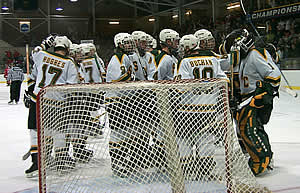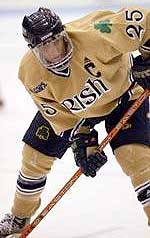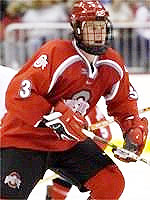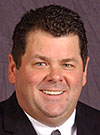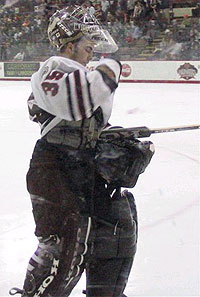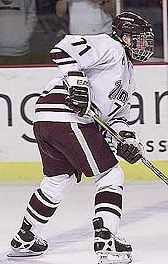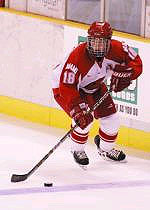We’re down to the final weekend of ECAC tournament action and the adrenaline is flowing through players, coaches, fans and the media. The league championship and an automatic NCAA bid will be decided in Albany this weekend between two returning teams and a pair of newbies to the Capital Region venue.
Harvard and Dartmouth are back from last year’s inaugural ECAC tournament at the Pepsi Arena. Top-seeded Colgate joins the Ivy duo along with surprising Clarkson — a staple in Lake Placid, the tourney’s old home.
Of the four teams, only the Crimson swept their quarterfinal series, upsetting higher-seeded Brown. The Raiders, Big Green and Golden Knights each reversed playoff odds by losing Game 1 and coming back to win their respective series. Clarkson’s victory was the most shocking as it scored 10 goals in the final two games to oust defending champ Cornell.
Clearly, any of the four schools could walk away with a title on Saturday night. While there are too many factors at play across the country to predict the chances of the ECAC getting two clubs in the NCAA tournament, we do know that it will likely only happen if a team other than the Raiders wins the title. Colgate and Dartmouth have outside chances of getting in if they lose in the finals, while Harvard and Clarkson need to capture the automatic bid to advance.
With the stage set and a ton at stake, let’s take a look at the match-ups for what will surely be an exciting four games over two days. For starters, here are the records of each semifinals participant against the rest of the field.
Colgate: 1-1-0 vs. Clarkson, 1-0-1 vs. Dartmouth, 0-2-0 vs. Harvard
Dartmouth: 0-1-1 vs. Harvard, 0-1-1 vs. Colgate, 1-0-1 vs. Clarkson
Harvard: 1-0-1 vs. Dartmouth, 2-0-0 vs. Colgate, 1-1-1 vs. Clarkson
Clarkson: 1-1-0 vs. Colgate, 0-1-1 vs. Dartmouth, 1-1-1 vs. Harvard
Now, onto the games we know.
No. 4 Clarkson (17-17-5, 8-12-2 ECAC) at No. 1 Colgate (21-11-5, 14-6-2)
This Season
Colgate 6, Clarkson 1 in Potsdam (11/15/03); Clarkson 1, Colgate 0 in Hamilton (2/27/04)
Recent Playoff History:
1995 ECAC Consolation in Lake Placid: Golden Knights 10, Raiders 5
Top Five Scorers
Clarkson – Mac Faulkner, Jr., LW, 17-25-42; Chris Blight, Jr., RW, 18-20-38; Jay
Latulippe, Jr., LW, 14-17-31; Rob McFeeters, Sr., RW, 6-17-23; Trevor Edwards, Sr., LW, 10-9-19.
Colgate – Jon Smyth, So., LW, 21-21-42; Adam Mitchell, Jr., F, 14-18-32; Kyle Wilson, So., C, 13-17-30; Kyle Doyle, Sr., F, 13-15-28; Darryl McKinnon, Jr., C, 11-11-22.
Between the Pipes
Clarkson – Dustin Traylen, So., 14-14-5, 2.60 GAA, .918 save percentage
Colgate – Steve Silverthorn, Jr., 18-8-4, 1.82, .926
An Inside Look
Clarkson shocked the ECAC by coming back to win back-to-back games in Lynah Rink after being left for dead last Friday night. Outscoring one of the country’s best defensive teams 10-5 in Games 2 and 3, the Knights’ quarterfinal series victory was, arguably, the program’s most significant win in years.
“As a program and a university,” explained Clarkson head coach George Roll, “[last season] was a struggle. But we put things behind us and the expectation was to get to Albany. Regardless of our finish, it’s meant a lot for the University to get here. The players aren’t satisfied yet, though.”
Less than a week ago, however, this major step in Roll’s rebuilding effort didn’t look like it would materialize.
“The first night,” he remarked, “[Cornell] really came at us. The most important thing against them is to stay ahead. They scored first and it took our rhythm away. We talked to the team after the game and told them to stay focused. Whether you lose 5-1 or in overtime, it doesn’t matter.
“[Assistants] Greg Drechsel and J.F. Houle did a great job after the first game showing the team the tape and we made adjustments. The next games we played very patient and took advantage of our opportunities.”
Unfortunately for Clarkson, the win came with a price. Rookie defenseman Matt Nickerson suffered a separated shoulder in Game 3 and is likely out for the contests in Albany. All weekend long he was the central focus of the Lynah faithful and was involved in a late-game scuffle in Game 1 when Cornell’s Paul Varteressian responded to Nickerson’s slashes by dropping his gloves.
“If he’d gone after the kid, we would not have won the series,” Roll said in reference to the game disqualification that would have resulted. Nickerson is no stranger to physical play, obviously, having set the ECAC and school record for penalty minutes in a season — and drawing the ire of opposing fans.
“You have to understand his background,” explained Roll. “He was used as an enforcer before coming here. There have been incidents when we’ve had to speak with him and we’ve sat him out, but since the St. Lawrence game (when he was tossed for a hit from behind) he’s stayed clean. He’s important to the team, and on and off the ice he’s matured.”
Nickerson logs a great deal of ice time for the Knights, so he’ll be missed; expect co-captain Tristan Lush to drop back to the blueline from his normal forward position. Roll has confidence in his other defensemen, though.
“Matt’s a physical presence,” Roll commented, “but Ken Scuderi has played unbelievably. And we’ve gotten a lot of other contributions from all of our D. We put four freshmen back there and they’ve grown as players and people. We’ve lived with their mistakes and now they are better players because of it.” Colgate, meanwhile, was pushed to the limit by the other North Country team, St. Lawrence. The Saints won Game 1 and forced the Raiders to fight and claw their way to a series win.
“It was different personnel,” said Colgate interim head coach Stan Moore, “but it was the same in many ways as a year ago when were down 0-1 to them before coming back to win the next two. The difference is that in Game 3 this year it was down to the wire. It was hotly contested.
“I think we had first game jitters versus St. Lawrence while they were able have theirs against Yale (the previous week). They were able to play with a ‘nothing to lose’ attitude. I’m not sure if we, as staff and players, fully knew how to deal with the bye week.”
The Raiders will not have to worry about extended time off this weekend as they jump right back into the action Friday at 4:30 p.m.
“Clarkson is not much different with their attitude than St. Lawrence,” said Moore. “They’ve gone into two buildings and came from behind to win last weekend. They don’t have anything to hold back. It is important that we match their intensity.”
But is it possible for a top seed to match the energy of an underdog?
“We’re all given a level of talent to work with,” explained Moore, “and you pit it against the opposing team. Everything in this league was quite close and we played closer to a playoff style game in Clarkson’s 1-0 shutout of us.
“We just need to display a level of patience commensurate with the situation we’re in. There’s no reason to play in a spiked fashion. It may lead us to be less dynamic, but we have to show the measure of consistency needed.”
A strong home team, the Raiders also posted an impressive 9-4-4 mark away from Hamilton. However, none of the current players were on the 2000 squad that played in the NCAA East Regionals in Albany. Will playing on the neutral ice of the Pepsi make a difference?
“We’re not making too much of the new rink,” said Moore. “We’ll assess the different characteristics of the rink to see what will work for us. Who knows? Maybe it’ll help us since there will be fans of all teams and people who are there just to see some good hockey games.”
Both teams match up well against each other, but Nickerson’s absence will hurt Clarkson’s chances of pulling off another upset. More than anything else, though, we’re more confident picking the better all-around squad — a Colgate team that ranks fifth nationally in scoring defense (2.05), ninth in penalty killing (86.5%) and 12th on the power play (19.4%).
Our pick: Colgate 4, Clarkson 2
No. 3 Harvard (16-14-3, 10-10-2) at No. 2 Dartmouth (14-9-9, 10-5-7)
This Season
Harvard 2, Dartmouth 2 in Hanover (11/8/03); Harvard 4, Dartmouth 0 in Cambridge (2/28/04)
Recent Playoff History
2003 ECAC Semifinals in Albany: Crimson 5, Big Green 3
2001 ECAC Consolation in Lake Placid: Crimson 3, Big Green 2 (ot)
Top Five Scorers
Harvard – Tom Cavanagh, Jr., C, 14-19-33; Tim Pettit, Sr., F, 10-22-32; Tyler Kolarik, Sr., F, 12-18-30; Brendan Bernakevitch, Jr., F, 9-17-26; Dennis Packard, Sr., F, 9-11-20.
Dartmouth – Lee Stempniak, Jr., F, 15-21-36; Hugh Jessiman, So., F, 16-17-33; Grant Lewis, Fr. D, 3-22-25; Mike Ouellette, So., F, 15-9-24; Eric Przepiorka, So., F, 7-16-23.
Between the Pipes
Harvard – Dov Grumet-Morris, Jr., 14-13-3, 2.33, .915
Dartmouth – Dan Yacey, Jr., 13-9-8, 2.44, .914
An Inside Look
The Big Green return to the semifinals for the third time in four years; the Crimson are back for their fourth straight appearance. What’s more, Friday’s contest will be a rematch of last season’s evening semifinal tilt in Albany in which Harvard emerged victorious 5-3. That game also marked a new era for Dartmouth between the pipes, although no one knew it at the time.
Down 4-1 in the second period, the Big Green pulled starter Nick Boucher and replaced him with Dan Yacey. The relatively inexperienced netminder didn’t allow a goal as his team climbed to within 4-3 before the Crimson sealed the victory with an empty-netter. Yacey got the start the next day in the Third Place game and bested Yann Danis for the win.
“I liked the way he played in Albany last year,” said Dartmouth coach Bob Gaudet, “and I thought it was a good way to go into the offseason. When he played, he played really well. Then, he came into the season as a different kid. From the start of the preseason he’s looked confident.”
A week ago we picked RPI to oust Dartmouth in the quarterfinals based on Nathan Marsters’ playoff experience over his opposing goaltender. Yacey proved us wrong. After losing Game 1, the junior netminder posted back-to-back shutouts against the league’s top offense to lead the Big Green to a series win.
“He played great,” Gaudet said. “He was really focused. ‘Yace’ is an excellent goaltender. He’s unheralded and hasn’t really shown up on the radar screens of others. But he was great and really excited.
“He took off at the end of the season. I’m pleased to see the progression he’s had. We knew he had it in him and now we see it.”
Harvard, meanwhile, needed only two games to dispose of Brown.
“We played very well,” explained head coach Mark Mazzoleni, “but we’ve been playing pretty darn well over the last six weeks (8-3-1). Sometimes you can play well and still come up short.”
That hasn’t been the case recently, though, as the Crimson have won five in a row. An improved and consistent offense is a big reason. They’ve outscored opponents 19-7 over those five games and are getting contributions from up and down their lineup.
Charlie Johnson, Kevin Du, Ryan Maki, Tyler Kolarik, Brendan Bernakevitch, Rob Fried, Dennis Packard, Noah Welch, Tim Pettit and Tom Cavanagh. Each of those Harvard skaters has scored at least once in the last five games and since the playoffs began, Kolarik, a.k.a. “Mr. March,” is on fire once again with three goals and two assists.
“That’s a special attribute for an athlete,” said Mazzoleni about Kolarik performance in the postseason. “When everything is on the line, it’s how you handle the situation.”
“Mr. March” has a history of playoff heroics dating back to 2002 when he scored the overtime winner in the ECAC finals against Cornell with a cast on his wrist. In his career, he has 21 points (8g, 13a) in only 14 league tournament games.
“All year,” Mazzoleni remarked, “he’s handled scoring opportunities, but recently we did two things. First, we moved where he’s been on the power play. Now he’s down low. And, second, we put him with [rookies] Kevin Du and Steve Mandes.
“Du [and Kolarik are] right-handed shots and Kolarik plays the off [wing], so Du looks for him.”
The line has been very effective since being united on Valentine’s Day and provides the Crimson with a fast and aggressive style of play that had been missing for most of the season.
“They are three quick skaters,” said Mazzoleni. “They work hard and after weeks of being together, they’ve found good chemistry and are part of why the team has come on. The freshmen have adapted well. They’re really not freshmen anymore with how they play.
“They are more comfortable with their surroundings. By Christmas time, nothing really surprises them anymore and as they do well they get more opportunities and confidence.”
Another one of those rookies is defenseman Dylan Reese, who missed the bulk of the season to a back injury.
“He’s a threat on both sides of the puck,” described Mazzoleni. “That’s why we wanted to get Dylan. He adds a real element to the team. The defensemen have to be an integral part of it and he’s rounding into game speed.
“It takes a month to get your rhythm going. After being out so long, he’s had to start from scratch.”
With so many weapons at its disposal, Dartmouth knows this isn’t the Harvard team that struggled for most of the season, but instead it more closely resembles the club experts expected would finish first.
“They are an excellent team,” said Gaudet. “It seems like ancient history when they were picked No. 1 in the preseason. They have a boatload of talent and are a veteran team with nine seniors. The team is completely Mazzoleni recruiting classes and he’s done a good job. They’ve been through the battles in the NCAAs and the ECACs and won.
“It’s a good challenge for us. To some degree it has to be irrelevant who we play. The further you go in the playoffs the better teams will be. It’s a bigger challenge every step we go. We just need to play hard, air it out and see what happens.
“I like this, these one-game deals.”
In the last game between the two Ivy League foes — who will be playing for the 175th time on Friday — Harvard shut down the Big Green’s powerful and talented forwards. Dartmouth also lost rookie sensation Grant Lewis early in the contest en route to being blanked 4-0.
“Dov Grumet-Morris played a really super game,” Gaudet said about Harvard’s netminder. “We squandered some opportunities in the first half of the game and he really nullified us. It wasn’t so much a bad game for us, but I don’t think it’ll hurt us to have played them recently.”
That night, the Crimson debuted its neutral-zone trap. They have not lost since, which begs the question of how Dartmouth — led by Hugh Jessiman, Lee Stempniak and Mike Ouellette — plans on breaking through the defensive scheme.
“The trap is very much overrated,” commented Gaudet. “Every team traps to a certain degree and at every level teams do it, from the best to the weakest. You teach kids how to play a bunch of different styles.
“We need to react. If we’re facing our opponents, they aren’t coming in with three guys, but if our backs are to them you can be sure they’ll send two guys in.
“I don’t expect Harvard to back off and will probably be hard-pressed to find them trapping. I don’t think it is really successful on a regular basis. If they do [trap], I think it’ll be a mistake.”
Riding its longest winning streak since the 1993-94 campaign, Harvard will be up against its biggest challenge in weeks. And while Yacey has clearly elevated his play of late for Dartmouth, the Crimson present too much of a challenge in too many areas right now. We’re sticking with the “sexy” pick to make it to the ECAC Championship game for the third straight season — which would be a first in the program’s history.
Our pick: Harvard 3, Dartmouth 1
It’s a tough and we’d probably have better luck just flipping a coin, but we predict a Colgate-
Harvard championship clash. It’ll be a tough game for both squads as the Raiders will look to
control the action with their steady, consistent pace. The Crimson won both games against
Colgate (4-2, 3-1) this season and Stan Moore readily admits that Harvard seems to have his
team’s number. That’s a bad sign, especially with a much-improved Crimson sextet flying high.
Our pick: Harvard 4, Colgate 1
Our Third Place Pick: Dartmouth 3, Clarkson 2
If We Had a Vote
The ECAC announces its annual awards Thursday night and there are sure to be some surprises — or at least some winners that will result in much debate among fans. Nobody asked us, but since there’s always room for more discussion, we’ve decided to give our thoughts on the players we think are the best of the bunch overall, not just in league play.
Player of the Year – Steve Silverthorn, Colgate
The popular choice would probably be the league’s point-leader Jon Smyth, but defense and goaltending win championships. Enter Silverthorn. Heading into Albany, he’s posted the nation’s fourth-best goals against average (1.82) and sixth-best save percentage (.926). All of his major numbers are career highs, including his 18 wins and three shutouts. More importantly, the team didn’t start winning consistently until he grabbed the starting job in goal. The result was nationally-ranked Colgate’s first ECAC regular season title since 1990 and a possible trip to the NCAAs.
Most Improved Player – Jon Smyth, Colgate
Numerous players showed strong improvement, but no came close to Smyth. As a rookie he scored twice — once in February and again in the playoff — that’s it. His three points in 25 games didn’t earn him much respect coming into this season, which was the general view of the Raiders as well. This year, however, Smyth had three points by November 1 and finished the regular season with 21 goals and 39 points overall. He led the ECAC in tallies (17) and was tied for first in points (28). Smyth enters the semifinals with 42 points — a 1,400% improvement in just 11 more games.
Rookie of the Year – Brian Ihnacak, Brown and Grant Lewis, Dartmouth
A potent duo that excelled offensively from two different positions, we thought it only fair to award them each a share of our hardware. Ihnacak provided the Bears with a new element up front and lead the ECAC in rookie goals and points both overall (10g, 30p) and in league games (8g, 25p). He also led the way in overall and ECAC power play points (23 and 21, respectively) and was in the nation’s top 10 in rookie scoring. Lewis’ emergence helped the Big Green fill expected offensive holes from the blueline. Ranked third in overall points among conference defensemen (25), he has seven more than the next closest freshman. In ECAC play, he was the top-scoring blueliner in any class with 18 assists and 21 points and currently ranks third in the country in defensemen scoring and in the top 10 in freshman points.
Best Defensive Forward – Ben Barr, Rensselaer
He’s a pest to top players around the league … and that’s a major compliment. A strong leader and versatile player, Barr contributed offensively as well. He followed up a 24-point 2002-03 season with a career-best 25 this year — including two shorthanded tallies. His defensively play up front made him easy to use with a variety of linemates and he was one of the major keys for RPI’s sudden turnaround from 12 wins last year to 22 this season. Barr also made an impact on reducing the team’s goals against by a whopping 45 markers.
Defenseman of the Year – Scott Basiuk, Rensselaer
For us, this award is reserved for the best two-way defenseman and the Engineers’ senior had the best all-around season among ECAC blueliners. In anchoring the fourth-best team defense in the conference, Basiuk played against opponents’ best forwards and, at times, completely dictated play. Offensively, he posted more points this year (26) than in the last two seasons combined; he was second on the team in power play goals (eight), third in goals (11) and fourth in points. His leadership, size and ability to excel at both ends of the ice make him a natural choice.
Goaltender of the Year – Yann Danis, Brown
Yes, his numbers were off down the stretch, but he still finished with the second-best save percentage in the country (.942) and third-best goals against average (1.81). We considered RPI’s Nathan Marsters (21 wins, .922), Colgate’s Steve Silverthorn (18 wins, 1.82 GAA, .926) and Cornell’s David McKee (1.84 GAA, .920), but the one statistic that stood out for us was that Danis faced 30.3 shots per game. The other three goalies each faced 25 or fewer and that adds up over the season. Add in that he was the most feared player in the league and lived up to it and the award is his.
Coach of the Year – Stan Moore, Colgate
This was probably the easiest choice of the bunch. No disrespect to the great job done by RPI’s Dan Fridgen, but Moore righted the emotional ship of a shattered team in October and took it to a regular season title. Picked to finish eighth in the preseason coaches and media polls, he took over Colgate’s reins when Don Vaughan stepped up into the administration. His squad posted the fifth-best defense in the country (2.05) and an 11-3-3 record in 2004. If Moore wins this award on Thursday it’ll be his second honor in just three seasons as a head coach. Hello, Princeton? Are you paying attention?
Fans Can Support Diversity In Hockey Program
For the second straight year, the ECAC is teaming up with the Diversity in Hockey/Schenectady Police Athletic League to help support the hockey needs of Capital Region area children in the grant-funded program.
As part of the ECAC Championships this weekend, the league is encouraging fans to participate in this community outreach initiative. Fans will be able to participate in the sports memorabilia auction taking place each day (March 19 & 20) during the Fan Fest outside of the Pepsi Arena.
“The Diversity in Hockey Program is not only proud of its affiliation with the ECAC,” said Deb Donovan, the program’s director, “but grateful for its support of our continued effort to provide inner city children with the opportunity to play hockey, as well as to realize academic success.”
Founded in 2000, the program has afforded more than 50 children ages 9-15 residing in inner city and adjacent geographic areas the opportunity to learn and play hockey. As a result of concentrated hockey development, the players currently enrolled in the program are now able to play youth hockey at a competitive level.
The Diversity in Hockey Program also integrates an Academic Mentoring Program with the assistance of Capital District High School-age hockey players who act as both assistant coaches and school-week mentors. In addition, area players and coaches participate in the mini-program Hockey2Hockey, which assists players in developing game-playing strategies and techniques.
Updated TV Coverage for Championship
The ECAC recently announced its updated television lineup for championship weekend, with six other networks agreeing to pick up CN8’s main feed. Friday’s first semifinal game will air live at 4:30 p.m. on CN8, Time Warner (Central NY), Adelphia (Burlington/Hanover) and Empire Sports Network. Leafs TV will air the contest on March 20 at 7:30 a.m. Friday’s second semifinal game will air live at 7:45 p.m. on CN8, Time Warner and Adelphia. Empire (10:30 a.m.) and Leafs TV (11 a.m.) will air it on March 20.
Saturday’s championship game will air live at 8 p.m. on CN8, CSTV and Adelphia. Empire (3 p.m.), Leafs TV (3:30 p.m.) and Time Warner (4:30 p.m.) will air the contest on March 21. Cox Rhode Island will air the game at 1 p.m. on March 22.
According to the league, the agreements with the other networks will make the games available to 11 million homes, including 6.2 million in New England and five million in New York and Pennsylvania.
In Case You Missed It
With a career save percentage of .930 and a career goals against average of 2.20, Yann Danis shattered Brown’s records in both categories. The previous marks were a 3.08 GAA and a .909 save percentage.
Brown posted its second winning season in a row this year (15-11-5), earning back-to-back over-.500 campaigns for the first time since 93-94/94-95.
Mac Faulkner’s 42 points is the most by a Clarkson player since current Ottawa Senators forward Todd White posted 74 (38g, 36a) for the Knights in the 1996-97 season.
Clarkson co-captain Tristan Lush has skated in a school record 146 career games. Meanwhile, rookie Matt Nickerson set Clarkson and ECAC records for most penalty minutes in a season (165). RPI head coach Dan Fridgen, a Colgate grad, previously held the league mark.
After averaging 2.73 goals per game through 34 games, the Knights have averaged 4.8 goals per playoff contest.
Senior captain Rob Brown broke Colgate’s games played record of 138 with Friday’s contest against SLU. He’s now at 141 and counting.
The Raiders have not allowed more than two goals in any of their last eight games (6-2-0), all of which have been one-goal affairs.
The Raiders’ Adam Mitchell has now scored three goals in the first minute of play this season. On Friday he notched one against the Saints at the :16 mark.
Colgate has advanced to the semifinals for the first time since the 1999-2000 campaign, which was also the last time the club reached the 20-win mark.
Dartmouth has now registered three playoff shutouts in the program’s history; all three have come against RPI: 8-0 in 1980, 6-0 on Saturday and 1-0 on Sunday. Big Green head coach Bob Gaudet was in net for the 1980 contest.
Harvard improved to 8-1-0 against Brown in the postseason and 7-0-0 in the quarterfinals.
Saturday’s Crimson victory was head coach Mark Mazzoleni’s 300th career win in his sixteenth season as a bench boss. His first victory came in his second game at Wisconsin- Stevens Point in 1985.
Harvard’s Tim Pettit appeared in his school-record 132nd career game on Saturday.
With last weekend’s three contests, Colgate and St. Lawrence have now played each other a remarkable 10 times in the last two seasons. The Raiders have posted a 5-3-2 mark in those battles, but have outscored the Saints just 24-23.
SLU’s Mike McKenna ended the season with a 2.45 GAA and .917 save percentage — the sixth-best marks in school history for a netminder with 20 or more appearances in a season. Over the year’s final 14 games, he posted a 1.95 GAA, .937 save percentage and 6-6-2 record.
The Saints set records for games played (41) and ties (six) in a season.
What’s On Tap
No. 4 Clarkson vs. No. 1 Colgate – The Golden Knights lead the all-time series over the Raiders 76-38-8 and are 8-1-1 against Colgate over the past 10 games. In ECAC playoff action, Clarkson is 5-1-1 against the Raiders and 18-3-1 overall on neutral ice against them.
No. 3 Harvard vs. No. 2 Dartmouth – This is just the third-ever playoff meeting between the teams, all within the last three seasons. The Crimson are unbeaten in their last eight games against the Big Green and lead the all-time series 114-52-8.
